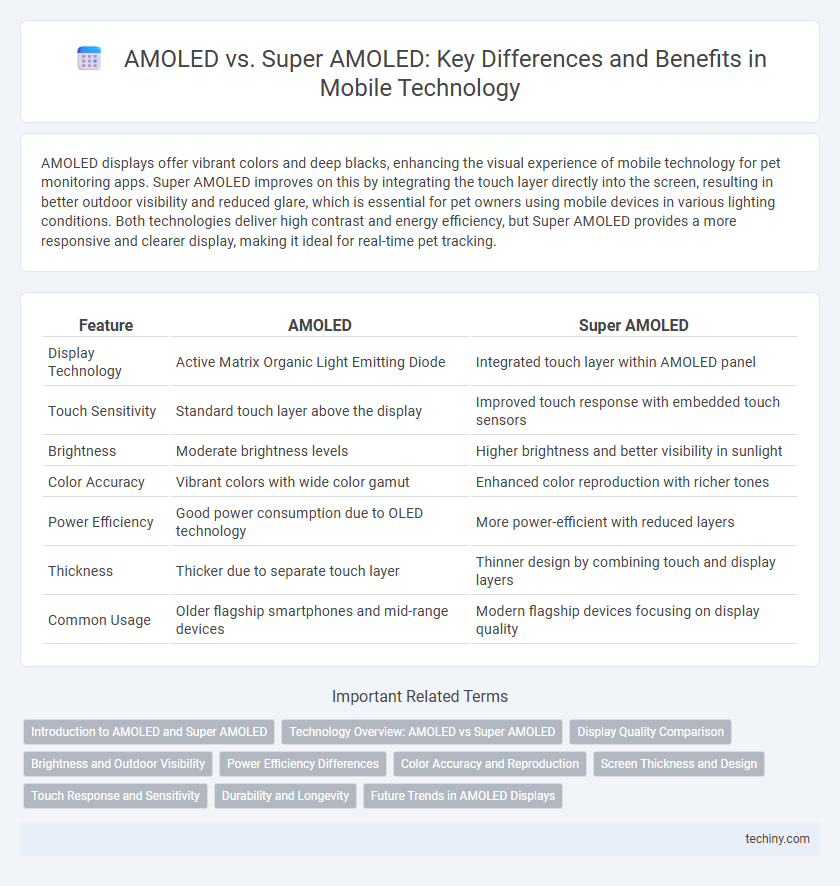AMOLED displays offer vibrant colors and deep blacks, enhancing the visual experience of mobile technology for pet monitoring apps. Super AMOLED improves on this by integrating the touch layer directly into the screen, resulting in better outdoor visibility and reduced glare, which is essential for pet owners using mobile devices in various lighting conditions. Both technologies deliver high contrast and energy efficiency, but Super AMOLED provides a more responsive and clearer display, making it ideal for real-time pet tracking.
Table of Comparison
| Feature | AMOLED | Super AMOLED |
|---|---|---|
| Display Technology | Active Matrix Organic Light Emitting Diode | Integrated touch layer within AMOLED panel |
| Touch Sensitivity | Standard touch layer above the display | Improved touch response with embedded touch sensors |
| Brightness | Moderate brightness levels | Higher brightness and better visibility in sunlight |
| Color Accuracy | Vibrant colors with wide color gamut | Enhanced color reproduction with richer tones |
| Power Efficiency | Good power consumption due to OLED technology | More power-efficient with reduced layers |
| Thickness | Thicker due to separate touch layer | Thinner design by combining touch and display layers |
| Common Usage | Older flagship smartphones and mid-range devices | Modern flagship devices focusing on display quality |
Introduction to AMOLED and Super AMOLED
AMOLED (Active Matrix Organic Light Emitting Diode) technology utilizes organic compounds that emit light when an electric current passes through, enabling vibrant colors and deep blacks with energy efficiency in mobile displays. Super AMOLED integrates the touch layer directly into the screen rather than as a separate layer, resulting in thinner displays, better sunlight visibility, and improved touch responsiveness. These enhancements make Super AMOLED a preferred choice in high-end smartphones for superior visual performance and user experience.
Technology Overview: AMOLED vs Super AMOLED
AMOLED (Active Matrix Organic Light Emitting Diode) technology uses an active matrix of OLED pixels that generate light individually, providing vibrant colors and high contrast with energy efficiency. Super AMOLED integrates the touch sensor directly into the display rather than overlaying it, resulting in improved touch sensitivity, reduced glare, and thinner screen construction. The key difference lies in Super AMOLED's enhanced visibility under sunlight and better power management compared to traditional AMOLED panels.
Display Quality Comparison
AMOLED displays offer vibrant colors and deep blacks due to their self-emissive pixels, but Super AMOLED enhances this technology by integrating the touch layer directly into the screen, resulting in better visibility under sunlight and reduced display thickness. Super AMOLED panels provide higher contrast ratios, improved color accuracy, and lower power consumption compared to standard AMOLEDs, making them ideal for immersive mobile experiences. This integration also minimizes glare and reflections, significantly enhancing outdoor readability and overall display quality.
Brightness and Outdoor Visibility
Super AMOLED displays enhance brightness levels by integrating touch sensors directly into the screen, resulting in more vivid visuals and superior outdoor visibility compared to traditional AMOLED panels. The improved pixel structure in Super AMOLED reduces glare and reflections, enabling clear content viewing even under direct sunlight. Increased brightness capacity reaches up to 800 nits in Super AMOLED, outperforming standard AMOLED brightness typically capped around 600 nits.
Power Efficiency Differences
Super AMOLED displays integrate the touch sensor directly into the screen, reducing power consumption compared to traditional AMOLED panels that use a separate touch layer. This integration minimizes light reflection, allowing Super AMOLED screens to operate at lower brightness levels while maintaining vibrant visuals, enhancing overall power efficiency. Consequently, devices with Super AMOLED technology generally experience longer battery life due to reduced energy requirements during display operation.
Color Accuracy and Reproduction
AMOLED displays offer vibrant colors and deep blacks due to their individual pixel illumination, enhancing color accuracy in mobile devices. Super AMOLED technology integrates the touch layer directly into the screen, reducing reflections and improving color reproduction under various lighting conditions. This integration leads to more precise color rendering and better visibility, making Super AMOLED displays superior for users demanding high-fidelity color performance.
Screen Thickness and Design
Super AMOLED screens integrate touch sensors directly into the display panel, significantly reducing overall screen thickness compared to traditional AMOLED displays, which have a separate touch layer. This integration enhances design sleekness and improves touch responsiveness, making devices thinner and more lightweight. The reduced layers also contribute to better outdoor visibility and lower power consumption, benefiting mobile technology design aesthetics and functionality.
Touch Response and Sensitivity
AMOLED displays feature an active matrix of organic light-emitting diodes, providing vibrant colors and deep blacks, but Super AMOLED technology integrates the touch layer directly into the screen, significantly enhancing touch response and sensitivity. This integration reduces screen thickness and improves touch accuracy by enabling faster and more precise detection of finger movements. Consequently, Super AMOLED screens offer superior responsiveness and smoother user interactions compared to standard AMOLED panels.
Durability and Longevity
AMOLED displays typically offer vibrant colors and high contrast but are prone to faster pixel degradation due to higher power consumption and organic material sensitivity. Super AMOLED technology integrates touch sensors directly into the display, reducing layers and improving durability by minimizing exposure to external damage and moisture. This integration also enhances longevity by reducing screen thickness, heat generation, and electrical consumption, resulting in a more robust and longer-lasting mobile screen.
Future Trends in AMOLED Displays
AMOLED technology continues to evolve with advancements in pixel architecture and energy efficiency, driving its adoption in high-resolution displays for smartphones, wearables, and foldable devices. Super AMOLED integrates touch sensors directly into the display, reducing screen thickness and improving outdoor visibility, setting the stage for future innovations in flexible and transparent displays. Emerging trends include micro-LED hybridization and enhanced color accuracy, positioning AMOLED as a cornerstone in next-generation mobile screen technology.
AMOLED vs Super AMOLED Infographic

 techiny.com
techiny.com